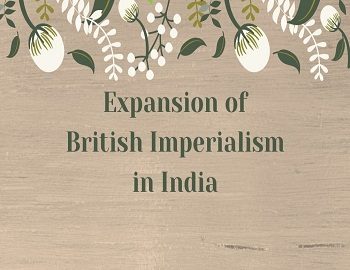Table of Contents
Expansion of British Imperialism in India:
Various Trading Companies:
The companies of Portugal, Holland, France, Denmark and England had set up their trading centres in India. They earned huge profits while dealing in spices, indigo, cotton textiles and saltpetre. Their competitions often resulted in conflicts. The British and the French weakened the Portuguese and Dutch traders.
British and French Companies:
These two dominating forces competed to control the Indian markets and politics of India. They fought three Carnatic Wars between 1744 and 1763. The English emerged victorious in these decisive battles.
The Britishers:
They had defeated the nawab of Bengal and got mastery over Bengal and Bihar. After gaining victory in the Battle of Buxar, the East India Company secured the right to collect revenue from Bihar, Orissa and Bengal. They occupied Mysore and the Maratha confederacy by gaining victory in the ‘Mysore Wars‘ and ‘Maratha Wars‘. They annexed Sind in 1843 A.D. They captured Punjab and the whole of India by 1856 A.D.
In this way beginning with Bengal, almost the entire country came under the rule of the English East India Company up to 1856. After the Revolt of 1857, the British government took over direct control of India. Many Princely States survived but they were free more in name than in fact. Britain’s conquest of India was complete.
The conflict between the English East India Company and the French was over establishing a monopoly of trade. After the English Company gained control, the country’s vast resources fell into its hands. There was no longer any need to bring money from England to buy Indian goods. These were purchased with the money made from British conquests in India and sold in England and Europe. Fortunes were made by the officers of the Company. India was known as the brightest jewel of the British Crown. With the coming of the Industrial Revolution (1750-1840 A.D.) in England, British goods poured into this country (from 1757-1947). This ruined the Indian handicraft industries. Million of pounds were drained out of India to England in the forms of profits and as payment to the British government as a direct tribute and Home Charges. India’s interests were subordinated more and more to British interests. In 1877, the British Queen took the title ‘Empress of India’, like one used earlier by the Mughals.
The British conquest led to several changes in Indian social and economic life. To extend Indian markets for British goods and to make use of India’s natural resources, railway construction was started on a large scale. British rulers gave special privileges to their own planters, and within a short time a number of tea, coffee and indigo plantation grew up. In 1833, all import and export duties were waived. Indian resources, both human and material, were used to promote the interests of British imperialism in China, Central Asia and Africa. To prevent the opposition from the Indian people, the British imposed laws to stifle the expression of public opinion. They excluded Indians from responsible positions in government and discriminated against them in other institutions and in social life.






![Muslim League [December 30, 1906] 7 Muslim League](https://gkscientist.com/wp-content/uploads/2021/05/Muslim-League.jpg)


Comments (No)